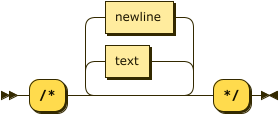SQL++ for Query Reference
- reference
This reference guide describes the syntax and structure of SQL++ for Query. It provides information about the basic elements which can be combined to build SQL++ statements. The Couchbase implementation of SQL++ was formerly known as N1QL.
The SQL++ language is composed of statements, expressions, and comments.
Statements
SQL++ statements are categorized into the following groups:
-
Data Definition Language (DDL) statements to create indexes, modify indexes, and drop indexes.
-
Data Manipulation Language (DML) statements to select, insert, update, delete, and upsert data into JSON documents.
Expressions
The following are the different types of SQL++ expressions:
Nested Path Expressions
In SQL++, nested paths indicate an expression to access nested sub-documents within a JSON document or expression.
For example, in the document below, the latitude of an airport is stored within the geo sub-document, and can be addressed using the nested path geo.lat:
[
{
"airportname": "Calais Dunkerque",
"city": "Calais",
"geo": {
"alt": 12,
"lat": 50.962097,
"lon": 1.954764
},
"latitude": 51,
// ...
}
]You can use nested operators to access sub-document fields within a document.
Comments
SQL++ supports block comments and line comments.
Block Comments
block-comment ::= '/*' ( text | newline )* '*/'
A block comment starts with /* and ends with */.
The query engine ignores the start and end markers /* */, and any text between them.
A block comment may start on a new line, or in the middle of a line after other SQL++ statements. A block comment may contain line breaks.
There may also be further SQL++ statements on the same line after the end of a block comment — the query engine does not ignore these.
Line Comments
line-comment ::= '--' text?
You can use line comments in Couchbase Server 6.5 and later.
A line comment starts with two hyphens --.
The query engine ignores the two hyphens, and any text following them up to the end of the line.
A line comment may start on a new line, or in the middle of a line after other SQL++ statements. A line comment may not contain line breaks.
Optimizer Hints
You can supply hints to the optimizer within a specially-formatted hint comment. For further details, refer to Optimizer Hints.